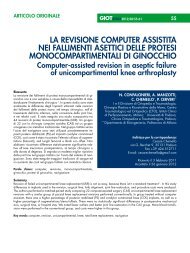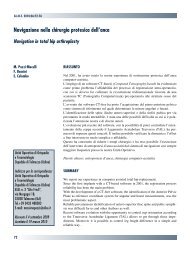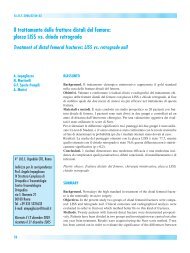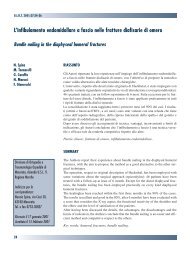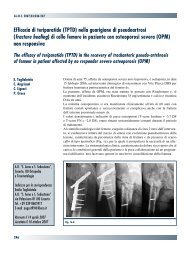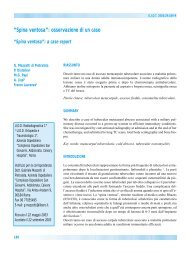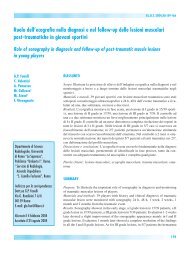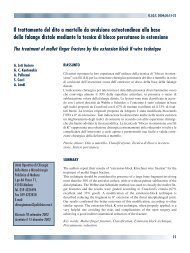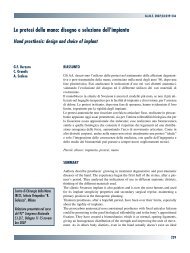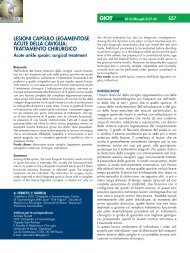Vol.XXXVII, Suppl. 1 - Giornale Italiano di Ortopedia e Traumatologia
Vol.XXXVII, Suppl. 1 - Giornale Italiano di Ortopedia e Traumatologia
Vol.XXXVII, Suppl. 1 - Giornale Italiano di Ortopedia e Traumatologia
You also want an ePaper? Increase the reach of your titles
YUMPU automatically turns print PDFs into web optimized ePapers that Google loves.
fattori <strong>di</strong> crEscita:<br />
appLicaZioni cLinichE nELLE<br />
LEsioni tEn<strong>di</strong>nEE, MuscoLari,<br />
LEgaMEntosE. stato dELL’artE<br />
growth factors: clinical applications<br />
in injuries of tendon, muscle and<br />
ligament. state of the art<br />
riassunto<br />
È stato <strong>di</strong>mostrato che proteine come i fattori <strong>di</strong> crescita (GF)<br />
sono degli efficaci promotori dei processi <strong>di</strong> guarigione e favoriscono<br />
inoltre il mantenimento <strong>di</strong> un ambiente tissutale adeguato<br />
e adatto ai processi riparativi.<br />
Essi si trovano, com’è noto, nelle piastrine che contengono inoltre<br />
citochine pro infiammatorie, chemochine e metalloproteasi.<br />
Il plasma autologo concentrato <strong>di</strong> piastrine (PRP) ci permette <strong>di</strong><br />
ottenere quantità adeguate <strong>di</strong> GF in modo relativamente semplice,<br />
poco invasivo e a basso rischio <strong>di</strong> reazioni avverse per<br />
il paziente.<br />
Applicazione cliniche nelle lesioni ten<strong>di</strong>nee. È stato <strong>di</strong>mostrato<br />
che il ten<strong>di</strong>ne è un tessuto sensibile alla stimolazione con fattori<br />
<strong>di</strong> crescita. Numerosi stu<strong>di</strong> in letteratura <strong>di</strong>mostrano l’efficacia<br />
delle infiltrazioni con GF nelle lesioni ten<strong>di</strong>nee, anche se non<br />
esiste piena concordanza nelle in<strong>di</strong>cazioni, nei mo<strong>di</strong> e nei tempi<br />
<strong>di</strong> somministrazione.<br />
Applicazione cliniche nelle lesioni muscolari. È stato <strong>di</strong>mostrato<br />
da stu<strong>di</strong> in vitro e su animale che i fattori <strong>di</strong> crescita sono<br />
ampiamente coinvolti nei processi <strong>di</strong> rigenerazione muscolare.<br />
Risultati incoraggianti si sono osservati in stu<strong>di</strong> su animale. Gli<br />
stu<strong>di</strong> clinici sull’uomo sono invece pochi e non ci permettono <strong>di</strong><br />
trarre conclusioni definitive.<br />
Applicazione cliniche nelle lesioni legamentose. Attraverso l’utilizzo<br />
<strong>di</strong> fattori <strong>di</strong> crescita, ci si potrebbe aspettare un’integrazione<br />
biologica del graft più veloce permettendo potenzialmente<br />
protocolli riabilitativi più aggressivi nelle ricostruzioni LCA artroscopiche.<br />
parole chiave: fattori <strong>di</strong> crescita, Platelet-rich plasma, ten<strong>di</strong>ni,<br />
legamenti, muscoli, lesioni<br />
p. VoLpi, c. Bait, a. quagLia, M. cErVELLin,<br />
E. prospEro, M. dEnti<br />
IRCCS Istituto Clinico Humanitas,<br />
Unità <strong>di</strong> Chirurgia del Ginocchio e <strong>Traumatologia</strong><br />
dello Sport, Rozzano, Milano<br />
In<strong>di</strong>rizzo per la corrispondenza:<br />
Piero <strong>Vol</strong>pi<br />
Istituto Clinico Humanitas IRCCS<br />
Via Manzoni 56, 20089 Rozzano (Milano)<br />
Tel. +39 02 82244680<br />
E-mail: piero.volpi@humanitas.it<br />
agosto2011;37(suppl.1):117-120 s117<br />
summary<br />
Data reported in literature shown that proteins such as growth<br />
factors (GF) are effective promoters of the healing process and<br />
promote the maintenance of an adequate and suitable setting<br />
for tissue repair processes.<br />
GF are contained in platelets that also contain pro-inflammatory<br />
cytokines, chemokines and metalloproteases.<br />
Platelet-rich plasma (PRP) allows obtaining adequate amounts<br />
of GF in relatively simple way with low risk of adverse reactions<br />
for the patient. Clinical application in tendon injuries.<br />
Tendon is a tissue responsive to stimulation with growth factors.<br />
Many stu<strong>di</strong>es demonstrate the effectiveness of infiltration<br />
with GF in tendon injuries even though there is not complete<br />
agreement in the in<strong>di</strong>cation, in the manner and timing of administration.<br />
Clinical application in muscle injuries. In vitro stu<strong>di</strong>es and animal<br />
stu<strong>di</strong>es show that growth factors are extensively involved in<br />
the process of muscle regeneration. Encouraging results have<br />
been observed in animal stu<strong>di</strong>es. Clinical trials on humans are<br />
few and do not allow us to draw definite conclusions.<br />
Clinical application in ligament injuries. Using growth factors,<br />
we might expect a faster integration of biological grafts. This<br />
would allow more hard rehabilitation protocols in arthroscopic<br />
ACL reconstructions. Further stu<strong>di</strong>es are needed.<br />
Key words: growth factors, platelet-rich plasma, tendon, ligament,<br />
muscle, injury<br />
introduZionE<br />
Nel recente passato sono stati condotti numerosi stu<strong>di</strong> sia<br />
preclinici sia clinici, a vari livelli <strong>di</strong> evidenza, che riguardano<br />
i fattori <strong>di</strong> crescita (Growth Factors: GF) e la loro<br />
correlazione con gli eventi biochimici connessi con la riparazione<br />
tissutale.<br />
Anche la pratica clinica ha seguito con slancio queste innovazioni<br />
al punto che, a oggi, numerosi me<strong>di</strong>ci nelle più<br />
<strong>di</strong>verse <strong>di</strong>scipline considerano i fattori <strong>di</strong> crescita come<br />
una valida scelta terapeutica a loro <strong>di</strong>sposizione.<br />
I principali fattori <strong>di</strong> crescita coinvolti nei processi riparativi<br />
sono simili tra loro nella maggior parte dei tessuti<br />
e senza dubbio lo sono per quanto riguarda i muscoli, i<br />
ten<strong>di</strong>ni e i legamenti.<br />
È stato <strong>di</strong>mostrato che proteine come Trasforming Growth<br />
Factor (TGF-beta), Platelet-Derivated Growth Factor<br />
(PDGF), Platelet-Derivated Epidermal Growth Factor<br />
(PDEGF), Insuline-like Growth Factor (IGF-1), Vascular Endotelial<br />
Growth Factor (VEGF), Fibroblastic Growth Factor<br />
(FGF) ed Epidermal Growth Factor (EGF) sono degli efficaci<br />
promotori dei processi <strong>di</strong> guarigione e favoriscono<br />
inoltre il mantenimento <strong>di</strong> un ambiente tissutale adeguato<br />
e adatto ai processi riparativi 1 2 .<br />
I fattori <strong>di</strong> crescita sono inoltre coinvolti nel processo infiammatorio<br />
e nel rimodellamento dei tessuti lesi.<br />
Essi si trovano, com’è noto, in gran numero nei granuli<br />
alfa delle piastrine che contengono inoltre citochine pro<br />
infiammatorie, chemochine e metalloproteasi.



